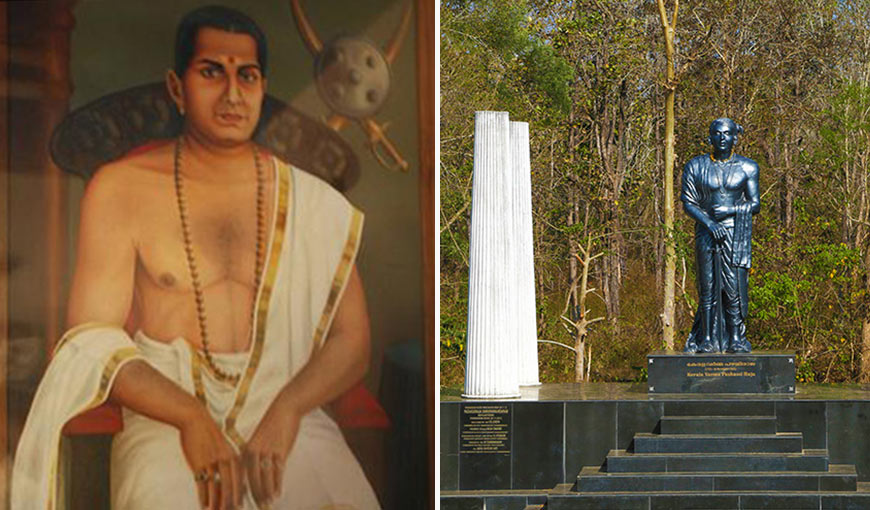Pazhassi Raja and Wayanad

Kerala Varma Pazhassi Raja was one of the earliest freedom fighters in India. He was a warrior prince and de facto head of the kingdom of Kottayam or Cotiote in Malabar, India between 1774 and 1805. His struggles with English East India Company is known as the Cotiote War. He is popularly known as Kerala Simham (Lion of Kerala) on account of his martial exploits. He was the only person to defeat Arthur Wellesley, 1st Duke of Wellington, ever in a war. Pazhassi Raja was a member of the western branch of the Kottayam royal clan.
Pazhassi Raja was born in the Padinjare Kovilakam (Western Branch) of Purannattu Swarupam, the royal clan of the kingdom of Kottayam in North Malabar. Kottayam covers what is today the Thalassery taluk of the Kannur District and Wayanad district, along with the Gudalur taluk of Nilgiris district.
Resistance to Mysore occupation
Depending on the rulers of the kingdom of Mysore, Pazhassi Raja’s warfare with Mysore troops could be classified into two phases. Hyder Ali was the ruler of Mysore during the first phase, which lasted from 1773 to 1782. As part of his second phase, he fought the troops of Tipu Sultan, Hyder Ali’s son and successor, between 1784 and 1793.
Resistance to British rule
Pazhassi Raja resisted British imperialism from 1793 onwards till his death in 1805. He fought two wars to resist British intervention in the domestic affairs of his kingdom. From 1793–1797 he fought over the question of the management of Kottayam and from 1800–1805 over the issue of who was to be master of Waynad.
On 1805, 30 November, Raja and retainers were camped close to Karnataka on the shore of a stream named Mavila or Mavila Tod [not far from Pulpally]. Raja and party were caught by surprise and an intense but short fight followed. Six rebels were killed. One of the earliest rebels to be killed was Pazhassi Raja.
But evidently, wounded Raja did live long enough for a few more minutes to raise his loaded gun and then tell Canara Menon, an East India Company minor official, not to come too close to his dying body and pollute it.[88] Raja’s contempt and sarcasm for a man who chose to serve unclean foreigner is evident. But it also showed his uncompromising stand towards collaborators and foreign invaders.
The precise nature of Raja’s death is controversial. Folklore insists that he committed suicide by swallowing a diamond ring to avoid capture after he was wounded but Baber says he was killed by a clerk named Canara MenonW. J. Wilson, who wrote on the history of the Madras Regiment, credits Captain Clafam and his six sepoys for killing.
Pazhassi Raja Tomb
After his death, a small memorial was made in Wayanad. The tomb marks the point where he was cremated after being shot by the British. Inside the Pazhassi tomb, tourists can see the prices possessions of the freedom fighter.
The memorial is managed by the State Archaeology Department and has mural paintings, antique bronzes, ancient coins, models of temples, umbrella stones, dolmenoid cists (quadrangular burial chambers with capstones), and similar megalithic monuments in its complex. Inside the memorial, there is an art gallery where the work of known artist Raja Ravi Varma is one display.
Pazhassi museum located nearby has a sword which is believed to have been used by Pazhassi Raja. The location of the tomb offers beautiful views of the surrounding valleys of Wayanad.
Visit this place while you stay at one of the best hotels in Wayanad.
recent posts
- Chembra Peak-Ideal Place for Trekking in Wayanad
- Spice Plantation in Wayanad
- Myth Behind Chain Tree in Wayanad
- Phantom Rock
- Kabini River
- Jain Temples at Panamaram
- Wayanad Waterfalls
- Edakkal Caves
- Kanthanpara Waterfall
- Banasura Sagar Dam
- Soochipara Waterfalls / Sentinel Rock Waterfalls
- Neelimala Viewpoint
- Sulthan Bathery
- Pakshipathalam
- Brahmagiri Trek
- Wayanad Wildlife Sanctuary
- Pazhassi Raja and Wayanad
- Monsoon in Wayanad
- Lakkidi View Point

